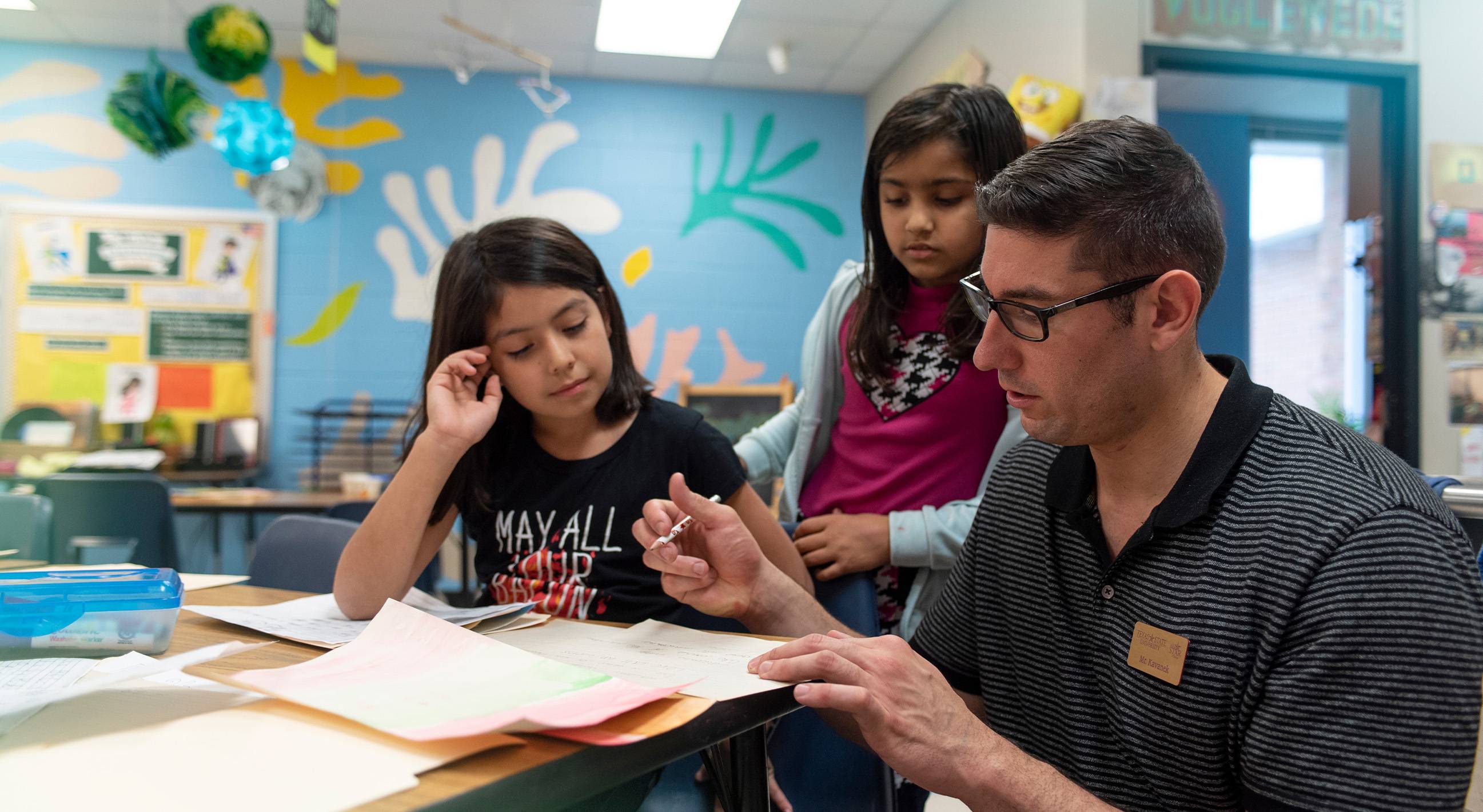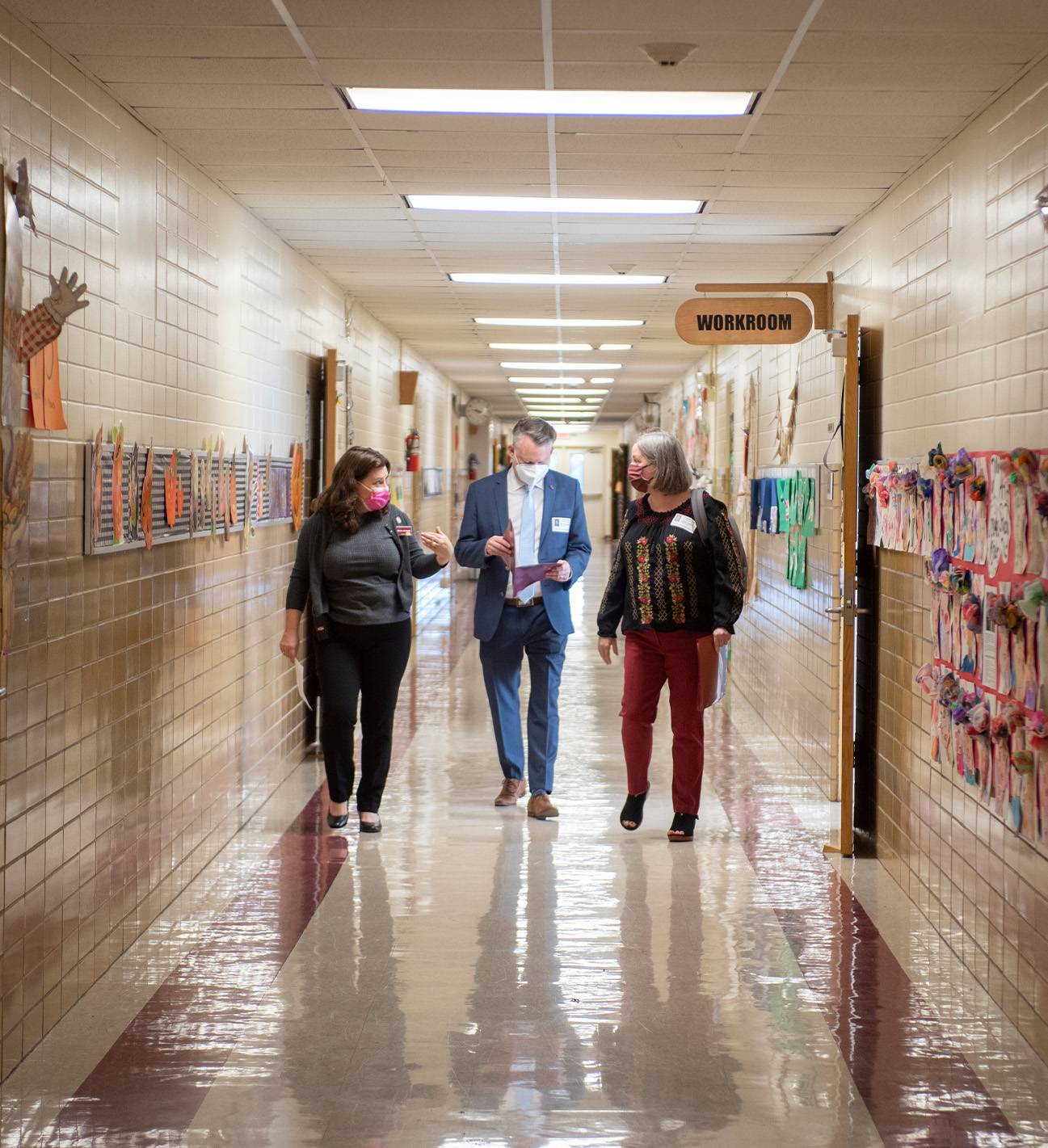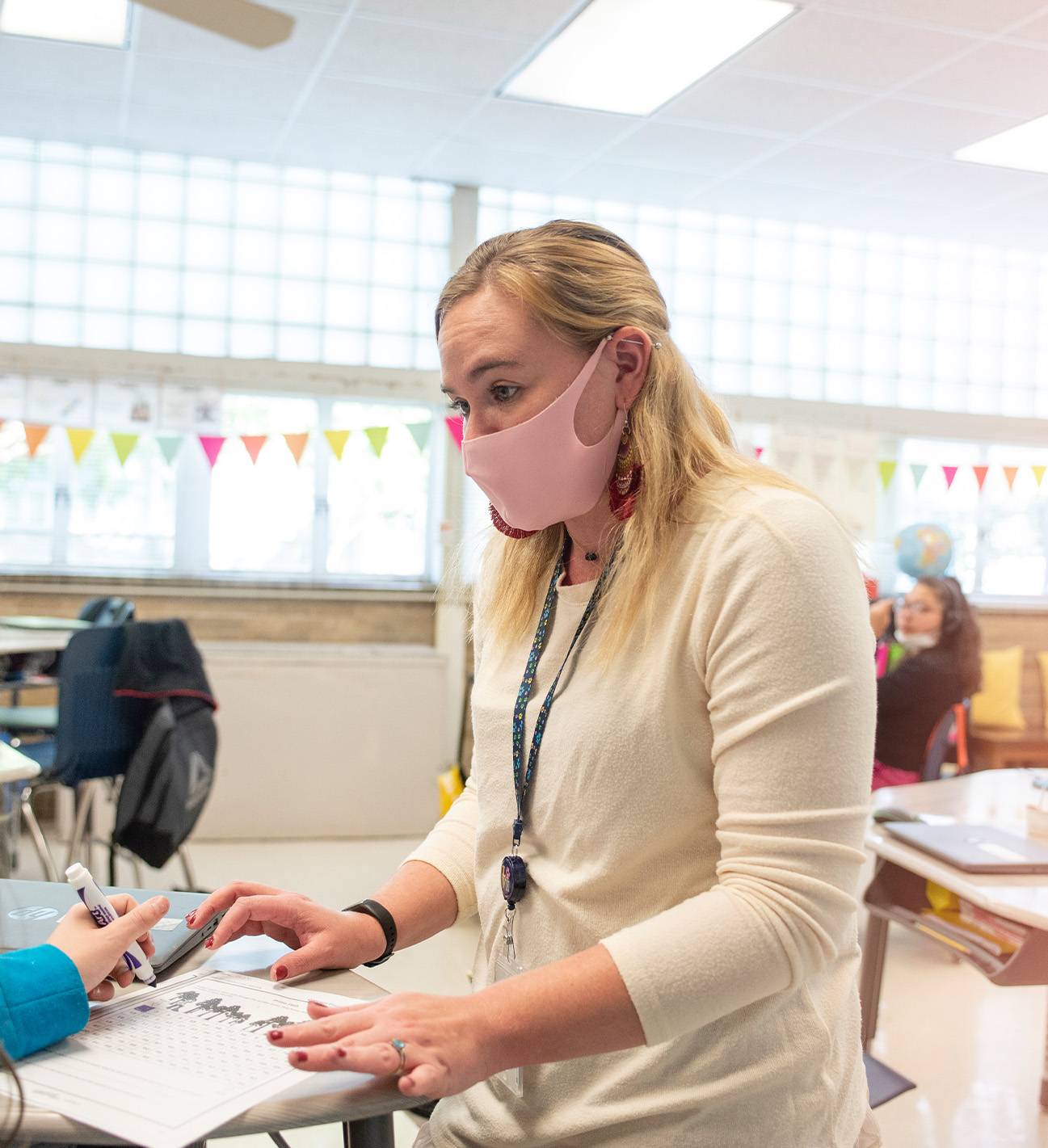Innovate and Educate

The College of Education is on the cutting edge of teacher preparation
By Leslie Asher Blair
High rates of teacher turnover and soaring numbers of those leaving the profession have been in the news a lot lately. Even before the pandemic, the national demand for teachers outstripped supply by about 100,000 teachers. Nationwide, COVID-19 prompted a number of teachers to leave the field at a time when teachers are more important than ever.
Since 2014, Texas has experienced a 14% decline of newly certified teachers. One thing is true across the country: Many students, especially English language learners, who might be better described as emergent bilinguals, and those from economically disadvantaged backgrounds, have seen their learning negatively impacted by the pandemic and they need teachers of excellence to help them.
With its long history of preparing highly qualified teachers, Texas State University has been quick to address these issues with innovative teacher preparation and new degree plans that reduce the number of hours required for students to graduate with a teacher certification.
“Texas State’s teacher preparation is more representative and inclusive of the communities of Texas than ever before. Our commitment is to support and serve the students who come to us from many different backgrounds and to prepare all teachers to work in culturally sustaining ways for the diverse communities of Texas,” says Dr. Michael O’Malley, dean of the College of Education.
Teacher preparation experiences have involved a semester in which students take their university classes at a PK–12 school campus, using this opportunity to also observe teachers in the classroom and interact with students — perhaps assisting with reading education or leading learning activities. After this semester of field-based learning, they are usually placed in other schools for student teaching for one additional semester. The College of Education has also been developing and implementing a new yearlong teacher residency program as part of the plan for what is next in teacher education. The program was conceived by PREP, based at Texas Tech University. PREP is now partnering with Texas State over three years so that groups of aspiring teachers will have an option to complete field-based coursework and student teaching within one integrated experience in one partner school district.
Partnering with District

Last year the College of Education partnered with Clear Fork Elementary, a Title I campus in Lockhart ISD, where 70% of the students are considered economically disadvantaged. Thirteen student teachers finished the yearlong teacher residency, embedded in Clear Fork’s classrooms. Eight of those students were hired by the district as teachers after graduation. This year Texas State has expanded the program to a second Lockhart school, Bluebonnet Elementary, and is partnering with San Marcos ISD in establishing a residency program.
The residency program also involves Texas State faculty members supervising the teacher residents during student teaching. Dr. Minda Lopez, professor of literacy in the Department of Curriculum and Instruction, oversees the residency program. She says, “Faculty who teach the coursework also supervise and give feedback to the students as they are teaching. You have a more developed relationship between the faculty member and student,” Lopez says.
The results are promising. “The residents see what a full year in the classroom looks like — from the first few days and weeks with kids and setting expectations all the way to the end of the year where they see how kids developed,” says Rebecca Leonard, principal at Clear Fork Elementary. She also said that the relationships formed with teachers were a big part of the residency experience. “You don’t lose any time as you would when a student teacher comes in for the spring semester. We have been able to gradually raise expectations and confidence for the student teachers.”
The student teachers also see how the teams of teachers evolve throughout the year. At Clear Fork, professional learning communities, which are small teams of teachers, meet weekly. “Aspiring teachers have the chance to witness firsthand how the teams work together. They see that there may be disagreements, but after struggling, they end up in a better place,” Leonard says.
She also noted that veteran teachers learn from the teacher residents, just as much as these college students learn from them. “Cooperating teachers said their skills grew because they were articulating strategies and structures. The student teachers are like mirrors for us — if your resident is getting feedback that they are asking low-level questions, then you need to ask, ‘is the teacher modeling lowlevel questions?’”
Sheri Holmes (B.S. ’21) is a fourth-grade teacher at Clear Fork who spent last year in the residency program. “Taking the coursework at Clear Fork was interesting. I felt like I could immediately take what I was learning and then put it into practice. It made the actual learning experience feel a lot more intentional rather than learning something at school, then not using it until six months later until actually teaching.
“The program gave me a lot of space — I had two teachers watching over me who could help me by saying, ̒Oh you should try this,’” she says. Being on the school campus with a group of peers also provided Holmes with a built-in network where the student teachers had the opportunity to bond and bounce ideas off each other.
Second-grade teacher Charlotte Schuetze (B.S. ’21) was also in the residency program last year. “I feel incredibly lucky to be teaching where I did my residency. It takes away the terrifying idea of starting a new career because you have such a huge head start in so many ways,” she says. “You start the year knowing the other teachers, the administration, and what is expected of you. I think one of the most underrated aspects is knowing that it is a school that you can personally fit into.
There is a huge advantage to knowing that you love the school before deciding to spend your first year there, especially for a first-year teacher.” Principal Leonard saw other advantages, too, in hiring teachers who had participated in the residency program on her campus. “When I met the residents, I told them, ‘Every day is an interview.’ I felt more confident with those two hires than a traditional hire with just a r sum and an interview,” she says. She also did not have any qualms about Holmes and Schuetze that sometimes show up when hiring first-year teachers. “Typically when I tell a parent their child has a first-year teacher, there is some apprehension on their part. I was able to reassure parents because I knew these two new teachers well.”

Raise Your Hand
Faculty in the Curriculum and Instruction Department are participating in the Raising Texas Teachers project sponsored by the Raise Your Hand Texas (RYHT) Foundation. Started by Charles Butt, chairman and CEO of H-E-B Grocery Company, the project engages faculty in long-term continuous improvement work and provides funding to support that work.
Dr. Lori Czop Assaf, professor of Curriculum and Instruction, is director for the project. She explains that the foundation evaluates the teaching training programs of emerging partners such as Texas State and works with the university to establish improvement goals. The foundation offers approximately $50,000 per school year to support the implementation of the continuous improvement plan. Texas State faculty are involved in six working groups focused on topics such as performance-based assessment of student teachers, teaching high-leverage practices that are critical to helping students learn, and supporting students’ social and emotional development. Aside from the money given to the university, the Raise Your Hand Texas Foundation pays for 10 faculty members to attend Teaching Works workshops sponsored by the University of Michigan.
Assaf says this program is unique because it focuses on faculty, and it supports teacher education — something that very few programs do. In 2022 Texas State will apply to become a full partner with Raise Your Hand Texas, which would provide $8,000 scholarships for up to 10 aspiring teachers and additional improvement funding for the teacher education program. ★
Support Grows for Student Teachers
Texas State University has accelerated its efforts to expand support for student teachers, and the response has been very positive.
In response to the call for support for student teachers, Carol (B.S. ’69) and Charlie Plassmann established the first scholarship created to support student teachers. The Carol Plassmann Endowed Scholarship provides needed support for student teachers and celebrates Carol’s lengthy career as a teacher in Texas. Donors continue to follow the Plassmanns’ lead as they are now developing additional scholarships for aspiring teachers and student teachers.
The college has also established new partnerships with Lone Star College and Austin Community College to provide high quality, equitable, and seamless transfer experiences for aspiring teachers coming to Texas State to complete their four-year degree and teacher certification.
A common thread across these initiatives is how they bring the university’s expert faculty and external coalitions together to collaborate on designing innovative teacher education models to meet the current needs and opportunities in school districts. “Partnerships are the key to our success,” says Dean Michael O’Malley, “and engaging with Raise Your Hand Texas and PREP has deepened the quality of our partnerships with local school districts; it’s impressive to see how creative, focused, and effective our faculty, school leaders and teachers, and these state and national organizations are as we all work together to prepare exceptional new teachers for Texas.”
Working with school district partners,
the College of Education has secured
$3 million in funds to provide
$20,000 stipends to more than
150 teacher residents
over the next 2.5 years.
The college has signed a new
partnership agreement with
San Antonio ISD to provide
$10,000
residency stipends to our students
who complete student teaching in SAISD
The Return of the Education Degree

An additional step that Texas State University has taken to improve teacher preparation is related to new degrees for undergraduates. Since 1987, the Texas Legislature has required aspiring teachers to earn a degree in a content area or interdisciplinary studies, with education coursework embedded within the degree.
To become certified, pre-service teachers had to take additional credit hours beyond the standard 120 hours needed to graduate. The result: It was taking students longer to graduate, and it meant more student debt.
Dr. Patrice Werner, recently retired associate dean in the College of Education, explained the conundrum faced by Texas State and other state institutions: “Essentially it limited the amount of time we could work with students to prepare them. It limited the number of education courses we could provide to a total of 18 credit hours, including student teaching.
“Since then, Texas has a growing population of diverse learners and the standards and requirements for teachers have changed. We struggled to meet the standards because of that limit on credit hours.”
In 2019 a group of universities, including Texas State, joined forces to request authorization in Texas for education degrees at the undergraduate level. Passing in both the Texas House and Senate unanimously, the revised legislation allows the conferral of education degrees and removes the cap on education credit hours. With that, Texas State developed two new education degrees: a bachelor of arts in education and a bachelor of science in education. Secondary education students may now double major in their field of study and in education with equal hours of coursework in each major. Elementary education students now earn a degree in their professional field of education, rather than interdisciplinary studies, and all education students take an integrated combination of discipline area and education courses. The design of these degrees also lowered the credit hours required of future teachers, thereby lowering both degree cost and time to degree completion.
As a result of the legislative change, Werner says, “We have been able to add coursework for English language learners and students with special needs, as well as increase the number of field experience hours.”
In May 2021, the first undergraduates since 1987 graduated with a degree in education. “In spite of [the old law], we had an incredible reputation for preparing strong teachers. We know so much more about teaching and learning now, and meeting the needs of diverse populations of learners. We have the freedom to design programs to meet these needs,” Werner says.
Faculty across all colleges involved in teacher education at the university collaborated in designing the return of the education degree. With strong, updated education degree plans in place and innovative teacher preparation programs, Texas State continues to build on its reputation, and its graduates are ready and willing to improve outcomes for children and meet the educational needs of communities statewide.